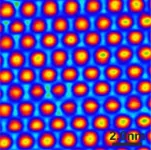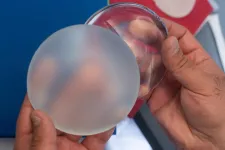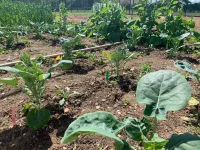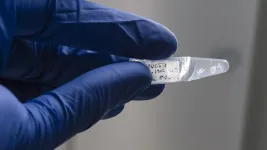Changes in farming practices could reduce greenhouse gas emissions by 70% by 2036
2021-06-21
(Press-News.org) Team used Argonne's GREET model to simulate changes, predict outcomes.
Scientists from the U.S. Department of Energy's Argonne National Laboratory participated in a study that shows innovation in technologies and agricultural practices could reduce greenhouse gas (GHG) emissions from grain production by up to 70% within the next 15 years.
Published in Proceedings of the National Academy of Sciences of the United States, the study identifies a combination of readily adoptable technological innovations that can significantly reduce emissions and fit within current production systems and established grain markets.
The study, "Novel technologies for emission reduction complement conservation agriculture to achieve negative emissions from row crop production," maintains that reductions in GHG emissions could be attained through digital agriculture, crop and microbial genetics and electrification. The new technologies, when implemented, promise to drive the decarbonization of agriculture while supporting farm resilience and maintaining profitability and productivity.
Technologies were grouped across three phases: optimize, replace and redesign. The team used Argonne's GREET® model to simulate adoption of the new technologies for holistic greenhouse gas emission reductions of grain production. Argonne developed GREET (the Greenhouse gases, Regulated Emissions, and Energy use in Technologies Model), a one-of-a-kind lifecycle analytical tool now used worldwide by government, industry and the science community.
The study offers insights for the development of possible new approaches for agriculture decarbonization and suggests entry points for public and private investment based on a timeline of expected returns on investments in new technologies.
"Our study emphasizes the importance of a two-pronged approach -- reducing farming emissions and maximizing soil carbon storage -- to addressing the climate crisis through agriculture. Practices that enhance soil carbon storage continue to gain momentum. Complementing this approach by developing and broadly applying emission reduction technologies, including seed genetics, is critical to achieving net negative production," said Dan Northrup, lead author of the study and director of special projects at Benson Hill, a St Louis based company leveraging the natural genetic diversity of plants to develop more healthy and sustainable food choices.
Argonne Energy Systems Division's senior scientist Michael Wang, who leads the Systems Assessment Center and is one of the study's principal investigators, added, "Our holistic assessment of agriculture decarbonization highlights technical areas and focus points so that U.S. agriculture will be a solution to the climate challenge."
INFORMATION:
Other research team members included Philip Benfey of Duke University, HHMI and Hi Fidelity Genetics, a company commercializing an in-field sensor-based root monitoring platform for crop plants; Bruno Basso of Michigan State University and CiBO Technologies, innovators of a breakthrough technology platform that accelerates regenerative agriculture; and Cristine Morgan of the Soil Health Institute, a nonprofit that safeguards and enhances the vitality and productivity of soil through research and advancement.
This research is funded by the SMARTFARM Program of DOE's ARPA-E and DOE's Bioenergy Technologies Office in the Office of Energy Efficiency and Renewable Energy.
The Office of Energy Efficiency and Renewable Energy supports early-stage research and development of energy efficiency and renewable energy technologies to strengthen U.S. economic growth, energy security, and environmental quality.
Argonne National Laboratory seeks solutions to pressing national problems in science and technology. The nation's first national laboratory, Argonne conducts leading-edge basic and applied scientific research in virtually every scientific discipline. Argonne researchers work closely with researchers from hundreds of companies, universities, and federal, state and municipal agencies to help them solve their specific problems, advance America's scientific leadership and prepare the nation for a better future. With employees from more than 60 nations, Argonne is managed by UChicago Argonne, LLC for the U.S. Department of Energy's Office of Science.
The U.S. Department of Energy's Office of Science is the single largest supporter of basic research in the physical sciences in the United States and is working to address some of the most pressing challenges of our time. For more information, visit https://energy.gov/science.
ELSE PRESS RELEASES FROM THIS DATE:
2021-06-21
A species of butterfly found in Sub-Saharan Africa is able to migrate thousands of miles to Europe, crossing the Saharan Desert, in years when weather conditions are favourable, scientists have found.
The striking Painted Lady (Vanessa cardui) butterfly has been shown for the first time to be capable of making the 12,000-14,000km round trip - the longest insect migration known so far - in greater numbers, when wetter conditions in the desert help the plants on which it lays eggs.
The international research team's findings increase understanding of how insects, including pollinators, pests and the diseases they carry could spread between continents in ...
2021-06-21
Lead levels in London's atmosphere have dropped drastically since lead additives in petrol were phased out, and currently meet UK air quality targets. However despite this drop, airborne particles in London are still highly lead-enriched compared to natural background levels, according to new Imperial research published today in PNAS.
The study found that up to 40 per cent of lead in airborne particles today comes from the legacy of leaded petrol. The researchers say this highlights the long-term persistence of contaminants introduced by human activities in the environment.
Lead author of the study Dr Eléonore Resongles, who carried out the work at Imperial's Department of Earth Science and Engineering, said: "Petrol-derived lead deposited decades ago remains an important ...
2021-06-21
One vision that is currently driving material scientists is to combine organic molecules (and their diverse functionalities) with the technological possibilities offered by extremely sophisticated semiconductor electronics. Thanks to modern methods of micro- and nanotechnology, the latter designs ever more efficient electronic components for a wide variety of applications. However, it is also increasingly reaching its physical limits: Ever smaller structures for functionalizing semiconductor materials such as silicon cannot be produced using the approaches of classical technology. Scientists ...
2021-06-21
Think about how many different pieces of technology the average household has purchased in the last decade. Phones, TVs, computers, tablets, and game consoles don't last forever, and repairing them is difficult and often as expensive as simply buying a replacement.
Electronics are integral to modern society, but electronic waste (e-waste) presents a complex and growing challenge in the path toward a circular economy--a more sustainable economic system that focuses on recycling materials and minimizing waste. Adding to the global waste challenge is the prevalence of dishonest recycling practices by companies who claim to be recycling electronics but actually dispose of them by other means, such as in ...
2021-06-21
BEER-SHEVA, Israel, June 21, 2021 - A team of scientists at Ben-Gurion University of the Negev (BGU) have invented an artificial nose that is capable of continuous bacterial monitoring, which has never been previously achieved and could be useful in multiple medical, environmental and food applications.
The study was published in Nano-Micro Letters.
"We invented an artificial nose based on unique carbon nanoparticles ("carbon dots") capable of sensing gas molecules and detecting bacteria through the volatile metabolites the emit into the air," says lead researcher Prof. Raz Jelinek, BGU vice president ...
2021-06-21
In recent years, many juvenile courts have adopted in-home detention with electronic monitoring tethers as an alternative to institutional incarceration. A new study examined whether this approach reduces recidivism among girls involved in the juvenile justice system. The study found that tethers failed to reduce reoffending among the girls; in fact, they may be harmful because in-home detention limits girls' access to treatment programs.
The study, by researchers at the University of Cincinnati (UC) and Michigan State University, appears in Justice Evaluation Journal, a publication of the Academy of Criminal Justice Sciences.
"We believe this ...
2021-06-21
HOUSTON - (June 21, 2021) - Rice University bioengineers collaborated on a six-year study that systematically analyzed how the surface architecture of breast implants influences the development of adverse effects, including an unusual type of lymphoma.
Every year, about 400,000 people receive silicone breast implants in the United States. According to FDA data, most of those implants need to be replaced within 10 years due to the buildup of scar tissue and other complications.
A team including researchers from the Massachusetts Institute of Technology (MIT), Rice, the University of Texas MD Anderson Cancer Center and Baylor College of Medicine published its findings online ...
2021-06-21
Field trials investigating healthy compounds in agronomically important brassica crops have underlined the "immense potential" of gene editing technology, say researchers.
The trials are the first field application of the technology in the UK since the reclassification of gene-edited crops as genetically modified organisms by the Court of Justice of the European Union (CJEU) in 2018.
The results come as the UK Government is determining whether to allow gene-editing approaches for the purpose of food production, following a DEFRA-led public consultation.
"Our results demonstrate the immense potential for gene-editing to facilitate crop improvement by translating discoveries in fundamental biological processes," ...
2021-06-21
New York (June 21, 2021)--The American Geriatrics Society (AGS) has published an updated version of the AGS Minimum Geriatrics Competencies for Graduating Medical Students, which were created to ensure that medical school graduates across the U.S. are prepared to provide high-quality care for us all as we age. A refresh of the original set first published more than a decade ago, the 27 competencies integrate new concepts that have emerged more recently in the field of geriatrics, including frailty and person-centered care, and are framed around five key areas of focus for all geriatrics healthcare professionals.
"The updated competencies reflect an evolution in how we frame the work of geriatrics health professionals, a greater understanding of frailty, and a greater focus ...
2021-06-21
SAN FRANCISCO, CA--June 21, 2021--The progression from a round ball of cells to an embryo with a head and a tail is one of the most critical steps in an organism's development. But just how cells first start organizing themselves with directionality along this head-to-tail axis is hard to study because it happens in the earliest days of embryonic development, in the confines of a mammal's uterus.
Now, scientists at Gladstone Institutes have created an organoid--a three-dimensional cluster of cells grown in the lab--that mimics the earliest developmental steps of the nervous system in embryos. The organoid is the first to show how human spinal cord cells ...
LAST 30 PRESS RELEASES:
[Press-News.org] Changes in farming practices could reduce greenhouse gas emissions by 70% by 2036




